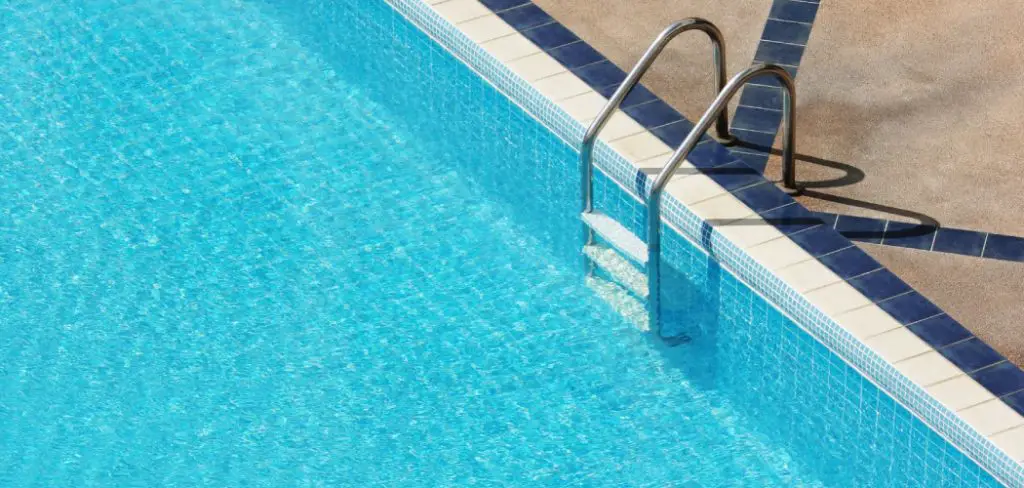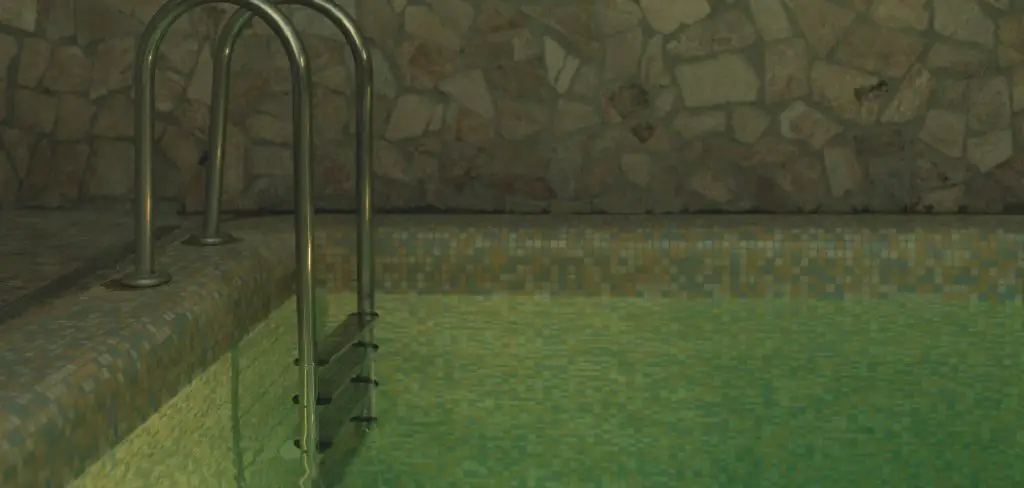To fix an unlevel inground pool, first, identify the cause of the unevenness, then use leveling techniques such as adding or removing soil or adjusting the pool supports as needed. Having an inground pool in your backyard can provide endless enjoyment and relaxation.
However, if you notice that your pool is unlevel, it can be frustrating and potentially dangerous. An unlevel pool can lead to issues such as water imbalance, structural damage, and even accidents. Therefore, it’s crucial to address this problem promptly.
This article will provide practical steps on how to fix an unlevel inground pool, ensuring it is safe, stable, and ready for enjoyment. By identifying the cause of the unevenness and using appropriate leveling techniques, you can restore your pool to its original state, ensuring many more years of poolside fun.

Assessment Of The Problem
Assessing the levelness of your inground pool is crucial for maintaining its structural integrity and ensuring a safe and enjoyable swimming experience. Before attempting to remedy an unlevel pool, a comprehensive assessment of the underlying problem is essential. This involves checking the pool level and identifying potential causes.
Checking The Pool Level
To begin the assessment process, you can use a water level, available at most hardware stores, to check the level of the pool water. Start by marking the water level at various points around the pool using duct tape or a waterproof marker. Compare the water level markings to determine any discrepancies.
Identifying Potential Causes
Unlevel pool surfaces can stem from several underlying issues. Possible causes include soil erosion, improper installation, or structural damage. Inspect the pool surroundings for signs of sinking or shifting. Additionally, closely examine the pool structure, including the deck and coping, for any visible cracks or uneven areas that could indicate underlying issues.
Diy Solutions
DIY Solutions:
Having an unlevel inground pool can be frustrating, but luckily, there are several DIY solutions that you can try to fix the problem yourself. In this section, we will explore two common methods for leveling an inground pool: adjusting the soil under the pool and using shims or leveling blocks.
Adjusting The Soil Under The Pool
If your inground pool is unlevel, one possible cause may be an uneven soil base beneath the pool. To fix this issue, follow these steps:
- Drain the Pool: Begin by draining the water from the pool. Use a submersible pump or a pool vacuum to remove all the water efficiently.
- Identify the Low Spots: Once the pool is drained, you’ll be able to identify the low spots that are causing the pool to be unlevel. These areas will need to be built up with soil.
- Add Soil: Fill the low spots with compacted soil until they are level with the rest of the pool area. Use a compacting tool, such as a hand tamper, to ensure the soil is properly packed.
- Recheck Level: After adding soil, use a level to check if the pool is now level. Make any necessary adjustments by adding or removing soil until the pool is completely level.
- Refill and Rebalance: Once the pool is level, refill it with water and rebalance the chemicals as necessary.
Using Shims Or Leveling Blocks
If adjusting the soil doesn’t solve the problem, another option is to use shims or leveling blocks to level the pool. Follow these steps:
- Drain the Pool: Begin by draining the pool as described in the previous section.
- Identify High and Low Spots: Use a level to identify the high and low spots in the pool area.
- Place Shims or Leveling Blocks: For low spots, place shims or leveling blocks underneath the pool to raise it to the desired level. Ensure that the shims or blocks are stable and secure.
- Check for Stability: After placing the shims or blocks, check the stability of the pool. Ensure that it is secure and does not wobble or shift.
- Refill and Rebalance: Once the pool is level and stable, refill it with water and rebalance the chemicals as necessary.
By following these DIY solutions, you can effectively fix an unlevel inground pool and enjoy a level and balanced swimming experience. However, if you are unsure or uncomfortable performing these tasks yourself, it is always best to consult a professional pool contractor to ensure the job is done safely and correctly.
Professional Fixes
Fixing an unlevel inground pool is crucial for maintaining its structural integrity and ensuring a safe swimming environment. While some minor leveling issues can be addressed with DIY methods, more complex problems may require the expertise of pool professionals. Seeking help from experienced pool experts can save you time, effort, and ensure a long-lasting solution.
Seeking Help From Pool Experts
When facing significant unleveling problems with your inground pool, it is wise to reach out to pool experts for assistance. These professionals have the knowledge, experience, and specialized tools to accurately diagnose the underlying causes of the unevenness and implement effective solutions.
Pool experts often begin by conducting a thorough inspection of the pool area, assessing the level of the ground and the pool structure. Through this process, they can identify any leaks, foundation issues, or poor installation practices that may be contributing to the unlevel pool.
Once the root cause is determined, the pool experts will discuss the necessary steps to rectify the problem. This may involve excavation, re-leveling the ground, or repairing any structural damage. They may also recommend additional measures to prevent future unleveling, such as reinforcing the pool’s foundation or using stabilizing materials.
By seeking help from pool experts, you can be confident that your unlevel inground pool will be brought back to its proper alignment, ensuring a safe and enjoyable swimming experience for years to come.
Considering Pool Resurfacing
In some cases, pool professionals may suggest pool resurfacing as a solution for unlevel inground pools. Pool resurfacing involves applying a fresh layer of finish to the pool’s interior, which not only enhances its appearance but also helps to address any leveling issues.
During the resurfacing process, pool experts will carefully prepare the pool’s surface by removing the old finish, repairing any cracks or damage, and then applying a new, smooth layer. This new layer will help create a more even surface, allowing better water circulation and alleviating the unleveling problem.
When considering pool resurfacing, it is important to consult with pool experts who can determine if this is an appropriate solution for your specific inground pool. They will assess the severity of the unleveling issue and the condition of your pool to provide tailored advice on whether resurfacing alone will suffice or if additional leveling measures are required.
Remember, pool professionals have the expertise to guide you towards the most effective fixes based on your unique situation. Consulting these experts will help you make informed decisions and ultimately achieve a level inground pool.

Preventive Measures
An unlevel inground pool can lead to a wide array of issues, ranging from structural damage to safety hazards. However, by implementing preventive measures, you can significantly reduce the likelihood of encountering such problems. By regularly inspecting and maintaining your pool and taking steps to protect the pool foundation, you can preserve the integrity of your pool and ensure a safe and enjoyable swimming experience for years to come.
Regular Inspection And Maintenance
Regular inspection and maintenance of your inground pool are crucial in preventing the onset of an unlevel pool. Here are a few important steps to consider:
- Check the pool’s water level: Ensure that the water level is consistently maintained to prevent any uneven pressure on the pool structure.
- Monitor soil erosion: Keep an eye out for any signs of soil erosion around the pool area, especially after heavy rains or storms.
- Inspect the pool deck: Periodically examine the pool deck for any signs of settling or unevenness, which could indicate underlying issues with the pool foundation.
- Assess the pool walls and floor: Regularly inspect the pool walls and floor for cracks, bulges, or other abnormalities that may indicate a potential unlevel condition.
- Schedule professional inspections: Consider hiring a professional pool maintenance service to conduct thorough inspections and address any underlying issues.
- Address any issues promptly: If any problems are identified during inspections, it’s crucial to address them promptly to prevent further escalation.
Protecting The Pool Foundation
Protecting the pool foundation is essential in preventing an inground pool from becoming unlevel. Here are a few measures to safeguard the pool foundation:
- Ensure proper drainage: Implement proper drainage systems to divert water away from the pool area and prevent soil erosion around the pool shell.
- Use high-quality backfill materials: When backfilling around the pool, utilize high-quality materials to ensure stable support for the pool structure.
- Consider reinforced concrete: In regions prone to soil shifting or instability, consider using reinforced concrete for the pool foundation to enhance its stability and durability.
- Avoid landscape modifications: Refrain from making significant landscape modifications near the pool area that could impact the stability of the pool structure.
Budget-friendly Tips
If you’re looking to address an unlevel inground pool without breaking the bank, these budget-friendly tips can help you get your pool back in shape without costly repairs.
Cost-effective Ways To Level The Pool
- Check the pool’s foundation for any visible issues.
- Fill in low areas with sand or soil to level the ground.
- Use pavers or concrete blocks to support the pool framework.
- Adjust the pool’s legs to ensure even distribution.
Avoiding Expensive Repairs
- Regularly inspect the pool for signs of unevenness.
- Address leveling issues promptly to prevent serious damage.
- Maintain proper water balance to prevent foundation problems.
- Consult a professional if significant unevenness is detected.
Safety Precautions
Before attempting to fix an unlevel inground pool, prioritize safety precautions to prevent accidents.
Ensuring Pool Stability
1. Prohibit pool use until it is properly leveled to avoid potential injuries or structural damage.
2. Secure necessary materials and tools to stabilize the pool foundation before starting any repair work.
Avoiding Risks Of An Unlevel Pool
1. Address the issue promptly as an unlevel pool poses risks of water imbalance and equipment damage.
2. Regularly monitor the pool’s water level and structure to ensure safety and prevent further complications.
Frequently Asked Questions Of How To Fix Unlevel Inground Pool
What Happens If An Inground Pool Is Not Level?
An unlevel inground pool can cause structural damage and water leakage. It can also lead to safety hazards and affect pool equipment performance. Regular maintenance becomes challenging if the pool is not level. It’s vital to address this issue promptly to avoid further complications.
How Out Of Level Can An Inground Pool Be?
An inground pool should be level, typically within one inch of accuracy, to ensure proper functionality and safety.
How Do You Level A Pool That Is Already Filled?
To level a filled pool, drain water gradually, measure slope, add soil if needed, compact soil, and refill.
How Many Inches Can A Pool Be Unlevel?
A pool can be unlevel by up to a few inches, but it is best to keep it within 1-2 inches for safety and proper water circulation.
Conclusion
To wrap up, addressing an unlevel inground pool is crucial for maintaining its structural integrity and ensuring a safe swimming experience. By following the step-by-step methods mentioned you can easily fix the problem and restore your pool’s balance. Regular maintenance and monitoring will help prevent future issues and prolong the lifespan of your pool.
Remember, a level pool means a happy pool!

